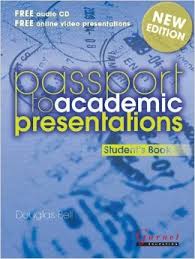Passport to Academic Presentations: New Edition

In business and academic circles today, knowing how to give effective presentations ranks high amongst the soft skills being taught and sought after in post-study employment. According to Mason (2015), communication skills refers to
“…more than just speaking the language. Communication skills involve active listening, presentation as well as excellent writing capabilities. One highly sought-after communication skill is the ability to explain technical concepts to partners, customers and coworkers that aren’t tech savvy” (http://www.livecareer.com/career-tips/career-advice/soft-skills-in-demand).
Though the Passport to Academic Presentations course was specifically designed for the target audience of academic students, the principles, concepts, and content can certainly be applied to the business world. In the business college where I teach, students hone their skills in research and how to communicate their findings through the medium of both written and oral presentations.
Douglas Bell has taken a straightforward approach to organising the course, beginning with Getting Started, and ending with Giving Persuasive Presentations. In between, other vital topics and skill areas are well covered, such as how to organise the material, when and how to deal with questions and answers from the audience, and the effective use of visual aids.
What I find particularly helpful are the checklists at the end of every unit which is essentially self-reflection, something I require my students to do when giving a practice presentation. In the book, it relates to the students’ evaluation of themselves and their personal progress made in acquiring language and skills. For example, “I know when and where to pause to help create impact” (p. 11). Here, the students rate themselves on a scale of five to one. If they tick the lower end of the scale (one or two), they are encouraged to go back through that particular section of the unit again.
In addition to the last unit on giving persuasive talks, I particularly like the language review and reference sections at the end. Also, students can benefit from the audio CD and have the opportunity to shore up their listening skills by reading the transcripts in the back of the book. Furthermore, the video excerpts for each unit are also accessible online and some have supplementary exercises the students can complete as they watch and listen to the video.
My only hesitation about the material relates to the cartoon graphics sprinkled throughout the coursebook. While I understand the value of using photographs and other visuals to avoid having text-laden pages, I feel some of them would more appropriately suit a much younger audience than university level. Having said that, I find this book could be used in classes of Upper Secondary and Gymnasium levels with students who have to conduct research and give presentations, as long as they have at least a B2 and higher level of English.
The Teacher’s Book offers useful tips for introducing a new point, as well as class management techniques for utilising the course material in class.
Garnet has put together what I feel is a comprehensive compact course for teaching presentation skills to upper intermediate to advanced level classes. The old saying ‘less is more’ applies here. With its straightforward cut to the chase approach of homing in on the key points and language needed to give effective presentations, students have the opportunity to spend less time with their heads in the book, doing exercises, and more time putting that new information to use by trying out what they have learned. Hats off to Mr Bell and Garnet for an excellent course I can heartily recommend.
JoAnn Salvisberg
Reference
Mason, B. (2015). Top 10 Soft Skills in Demand. Retrieved March 23, 2014, from http://www.livecareer.com/career-tips/career-advice/soft-skills-in-demand
